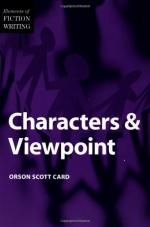
|
| Name: _________________________ | Period: ___________________ |
This test consists of 5 multiple choice questions, 5 short answer questions, and 10 short essay questions.
Multiple Choice Questions
1. Which series of novels by Robert Parker are listed as an example of characters that are influenced to change?
(a) Philip Marlowe.
(b) Sunny Randall.
(c) Jesse Stone.
(d) Spenser.
2. How much freedom do characters have to change in comedy?
(a) Less.
(b) None.
(c) More.
(d) Only the central character can change in comedy.
3. How are "showing" and "telling" defined?
(a) Showing affects only the characters, telling affects only the events.
(b) Showing gives a sense of immediacy, telling gives a sense of passivity.
(c) Showing gives a sense of passivity, telling gives a sense of immediacy.
(d) Showing affects only the events, telling affects only the characters.
4. What is "justification"?
(a) Presenting details around an action as it is occurring to explain that action.
(b) Presenting actions at the end of a narrative to explain earlier actions.
(c) Presenting actions early in a narrative to explain future actions.
(d) Presenting details about a character to explain a past, present, or future event.
5. In general, how do people write in comparison to the way they speak?
(a) They write slower than they speak.
(b) They write better than they speak.
(c) They write worse than they speak.
(d) They write faster than they speak.
Short Answer Questions
1. What is a Presentation perspective?
2. What reason does a character have for going through a random transformation?
3. What type of speech patterns do people use when they are talking into a recorder?
4. How can a character effectively have a random transformation?
5. How do the motives of a believable character affect the direction of the story?
Short Essay Questions
1. In Chapter 18, how does the author describe the potential of a writer in finding characters?
2. What are the advantages to using an omniscient or limited narration?
3. What happens when a reader interprets a change in a character that was not intended?
4. What are the most common tenses used in narration and how does the author describe the risks involved with using different ones?
5. What is comedy usually the result of, and what is humor based on?
6. What is the author's theory of how people experience transformations in life?
7. In what ways can a character change him/herself?
8. What is the difference between first person narrative and third person narrative?
9. What are some of the ways a writer can develop a story around characters that do not change?
10. How can a presentation perspective and a representation perspective be successfully applied?
|
This section contains 937 words (approx. 4 pages at 300 words per page) |

|




